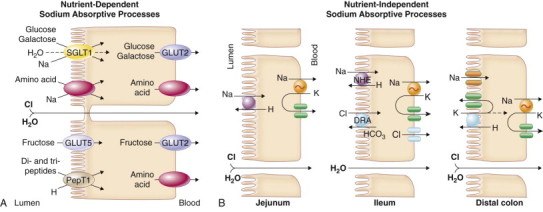FIGURE 142-1.


Mechanisms of intestinal transport of water and electrolytes.
A, Intestinal sodium absorption. Sodium is actively absorbed in villus cells of the small intestine and surface cells of the colon. The sodium-potassium adenosine triphosphatase (Na++,K++-ATPase) present on the cell basolateral membrane maintains a low intracellular Na+++ concentration and an electronegative cell interior favoring Na+++ movement across the apical membrane from lumen into cell. In the small intestine, glucose and galactose are taken up with sodium and water at the apical membrane by the sodium-glucose ligand transporter (SGLT1). Several different sodium-dependent amino acid carriers, some with overlapping substrate specificities, transport cationic, anionic, and neutral amino acids into villus cells. Dipeptides and tripeptides are transported by a hydrogen-coupled oligopeptide carrier, PepT1, that is driven by luminal hydrogen ions generated by the epithelial Na+/H++ exchanger. Fructose is taken up by the facilitative glucose transporter (GLUT5). B, Sodium also is absorbed by nutrient-independent transport processes in the small intestine and colon. The Na++/H++ (NHE) and Cl−/HCO3− (DRA) exchangers are inhibited by agents that elevate intracellular cyclic adenosine monophosphate (cAMP), cyclic guanosine monophosphate (cGMP), or calcium. C, Chloride secretion by intestinal crypt cells. Chloride can be secreted actively throughout the small intestine and colon. Intracellular mediators of secretion (cAMP, cGMP, Ca2++) open apical Cl− channels (cystic fibrosis transmembrane conductance regulator [CFTR], calcium-activated chloride channel [TMEM16]) and basolateral K++ channels. Chloride moves from crypt cells into the intestinal lumen, favoring movement of Cl− from the blood into cells by the Na++/K++/2Cl− cotransporter (NKCC1). Bicarbonate (HCO3−) also may be secreted via the CFTR channel. D, Regulation of intestinal water and electrolyte transport. Normally, the intestine is in a net absorptive state under the control of extrinsic adrenergic nerves from the sympathetic nervous system. Guanylin, the natural ligand for the Escherichia coli stable-toxin receptor (membrane-bound guanylyl cyclase [GC-C]), may be important in regulating local chloride secretion. The normal tone of the intestine is modified by the enteric nervous system, endocrine and inflammatory cells in the intestinal mucosa, and circulating hormones. The enteric nervous system releases a variety of neurotransmitters, some that stimulate chloride secretion (e.g., vasoactive intestinal peptide [VIP], acetylcholine) and others that promote sodium absorption (e.g., enkephalins, neuropeptide Y). Hormones produced locally from enterochromaffin cells (ECC) in the intestinal epithelium and inflammatory mediators released from immune cells directly affect enterocytes and nearby nerves. Circulating hormones (e.g., aldosterone, glucocorticoids) enhance sodium absorption in the intestine. Glucocorticoids also inhibit release of arachidonic acid and production of prostaglandin by inflammatory cells.
